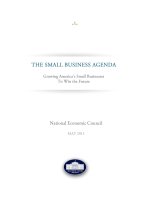Negotiate to Win: The 21 Rules for Successful Negotiating pptx
Bạn đang xem bản rút gọn của tài liệu. Xem và tải ngay bản đầy đủ của tài liệu tại đây (2.78 MB, 321 trang )
■
NEGOTIATE TO
WIN
The 21 Rules for
Successful Negotiation
JIM THOMAS
■
To my parents
CONTENTS
Acknowledgments vii
Introduction
ix
PART ONE:
THE WORLD IS A BIG BLUE BARGAINING TABLE
1. Haggling Is Hot 3
2. Trashing the Hallowed Halls of Haggling 6
3. Why Johnny and Janey Can’t Negotiate 16
4. Concessions Speak Louder Than Reasons 23
5. Win-Win Negotiating 31
PART TWO:
THE 21 RULES OF NEGOTIATING
6. The Critical Rules 49
Rule 1: No free gifts! Seek a trade-off
(“OK, if ”) for each concession you make.
49
iv CONTENTS
Rule 2: Start high. 58
Rule 3: Follow a dramatic initial concession
with sharply diminishing concessions.
67
Rule 4: Krunch early and often. 86
Rule 5: Never settle issues individually. Settle all
issues as a package—only as a package—at the end.
100
Rule 6: Conclude with a nibble. 103
Rule 7: Keep looking for creative
(high value–low cost) concessions to trade.
110
7. The Important but Obvious Rules 122
Rule 8: Do your homework. 122
Rule 9: Keep the climate positive. 127
Rule 10: Never assume that an issue is non-negotiable
just because the other side says it is. In reality,
almost everything is negotiable.
135
Rule 11: Never accept the other side’s first offer. 141
8. The Nice to Do Rules 146
Rule 12: Start slowly. 146
Rule 13: Set a complete agenda. 149
Rule 14: Discuss the small things first. 152
Rule 15: Be patient. 154
Rule 16: Use/beware the power of legitimacy. 157
Rule 17: Keep your authority limited. Try to negotiate
against people with higher authority.
161
Rule 18: Consider using good guy–bad guy. 168
Rule 19: Try to have the other side make the first offer. 171
Rule 20: Keep your team small and under control. 175
Rule 21: Try to have the other side travel to you. 181
9. Putting It All Together 184
CONTENTS v
PART THREE:
THE PRACTICE OF NEGOTIATING
10. Ethics 193
11. International Negotiating 203
12. Quickies 222
1. What if the other side won’t negotiate? 222
2. What if the other side is difficult or sensitive? 223
3. How do you negotiate with children? 225
4. How do you negotiate with your boss? 227
5. How do you negotiate your salary? 229
6. How do you negotiate your termination
and severance?
233
7. How do you negotiate a house purchase? 236
8. How do you get the best deal on a car? 245
9. How do you negotiate with airlines? 261
10. How do you negotiate with hotels? 263
11. How do you negotiate with rental car companies? 263
12. How do you negotiate with retail stores? 264
13. How do you negotiate with lawyers? 268
14. How do you negotiate with doctors? 270
15. How do you negotiate with contractors? 270
16. How do you negotiate with auto mechanics? 276
13. Concluding Thoughts 278
14. Thomas’s Truisms 281
Index 289
About the Author
Credits
Cover
Copyright
About the Publisher
ACKNOWLEDGMENTS
In writing Negotiate to Win, I’ve been blessed with the unsparing
assistance of family, friends, students, clients, and top-drawer nego-
tiators. It’s said that our best thoughts come from others; most of the
credit for this book belongs to them.
So many of my negotiating and legal colleagues contributed that
I cannot possibly list, let alone thank, all of them. I am deeply grate
-
ful for their priceless help. Thanks also to the tens of thousands of
students with whom I have had the pleasure of working in Negotiate
to Win seminars around the world. They have given me countless in
-
valuable insights.
Special thanks go to my clients—my early clients, in particular.
Thomas Edison once said, “I have not failed. I’ve just found 10,000
ways that won’t work.” The number of mistakes one can make in ne
-
gotiating is very large. I know this because I have made so many of
them myself. Trial and error is a brutally inefficient, incredibly costly
way to learn how to negotiate. It was at my clients’ expense that
I learned my craft, but it is because of them that I can offer you an
alternative.
viii ACKNOWLEDGMENTS
I wish to thank my children, Alex, Kelly, and Ryan, for their sac-
rifice of a lot of irreplaceable daddy-time during the writing of this
book. For his suggestions about real estate negotiating, I thank my
friend Bob Brown. For believing in me and guiding me through the
process, I thank my amazing agent Bonnie Tandy Leblang, who got
the show on the road. For his unfailing objectivity, good humor,
advocacy, advice, patience, and confidence, I thank my editor, Herb
Schaffner.
INTRODUCTION
Many books have been written about negotiating. Negotiate to
Win is about how to negotiate. Its purpose is to make you a better ne
-
gotiator, as quickly and painlessly as possible. If you’re a beginner, it
will show you, step by step, how to negotiate with confidence and
skill. If you’re more experienced, it will help you become a better ne
-
gotiator than you ever imagined.
Here’s the plan. When you boil down all the bromides, clichés,
theories, and folklore about negotiating, you wind up with a handful
of techniques that actually work. Those techniques—the 21 Rules of
Negotiating—are the heart and soul of Negotiate to Win and the
focus of each of its three parts. Part One gets you ready for the Rules,
Part Two gives you the Rules, and Part Three helps you use the Rules
more effectively. When you know the Rules, you’ll know negotiating.
Part One, The World Is a Big Blue Negotiating Table, takes a big-
picture look at the topic. In Chapter 1, Haggling Is Hot, we consider
some of the trends behind the growing, worldwide importance of
better negotiating. In Chapter 2, Trashing the Hallowed Halls of
Haggling, we detail the surprising shortage of practical information
x INTRODUCTION
about bargaining that inspired this book. A quick spin around the
planet in Chapter 3, Why Johnny and Janey Can’t Negotiate, reveals
that Americans are among the worst—if not the worst—negotiators
on Earth. We look at some cultures in which people bargain well,
and some reasons why Americans don’t. In Chapter 4, Concessions
Speak Louder Than Reasons, we mark the all-important boundary
between persuasion and negotiation. Often used interchangeably,
these terms describe vastly different processes; proficient negotiators
must know when to use one technique or the other, and why. The
final stop before the Rules is Chapter 5, Win-Win Negotiating.
There, we explain how humans come prewired with a deep-seated
need to save face, and, when we don’t, a burning desire to retaliate.
Win-win negotiating is, by and large, a function of human evolu
-
tion: If you vanquish the other side, they’ll retaliate.
The heart of the book is Part Two, The 21 Rules of Negotiating,
where the Rules are explained in detail. The seven Critical Rules are
covered in Chapter 6, the four Important but Obvious Rules in
Chapter 7, and the ten Nice to Do Rules in Chapter 8. Part Two con
-
cludes with Chapter 9, Putting It All Together, in which each of the
Rules is demonstrated in a hypothetical negotiation.
In Part Three, The Practice of Negotiating, the Rules meet the
real world. Chapter 10, Ethics, takes on the thorny subject of ethical
negotiating. We identify some bargaining moves that are clearly eth
-
ical, some that clearly aren’t, and some that aren’t so clear, along with
guidelines to help you recognize and avoid ethical traps. Globalism
is making Chapter 11, International Negotiating, more important
every day. Opportunities abroad are immense, but dealing with
the negotiating styles of other countries—especially those where
bargaining is commonplace—requires special care and attention.
Chapter 12, Quickies, offers specific tips on how to successfully
handle everyday negotiations with bosses, children, car dealers,
contractors, auto mechanics, and many others. We wrap up with a
key-points review and some final words of advice in Chapter 13,
Concluding Thoughts, and Chapter 14, Thomas’s Truisms.
INTRODUCTION xi
Let’s set a few ground rules before we begin:
■
I am living proof that God has a sense of humor. My cor-
nucopia of flaws includes being an incurable wise guy. No
matter how solemn the occasion, I can’t be deadpan for
more than about five minutes at a stretch. Many things in
the following pages are said in jest. I mean no disrespect or
offense, and I offer heartfelt apologies, in advance, for any
that might inadvertently be given.
■
Negotiate to Win is the product of experience, not research.
You won’t find the abundant references and footnotes
common to more scholarly works. This approach main
-
tains the long-standing disconnect between me and any-
thing that could remotely be called “scholarly,” while
simultaneously making room for stuff that somebody ac
-
tually might read.
■
Many of my examples depict people bargaining over some
imaginary order of widgets, doodads, or gizmos. I use such
examples only because they can be illustrated quickly and
grasped easily, and in no way to minimize the importance
of the countless negotiations that have nothing to do with
buying, selling, numbers, or tangible things.
■
The moment you write about somebody, sex becomes an
issue. In English, anyway. That’s because English doesn’t
have a gender-neutral, third-person-singular pronoun. In
English, everybody has to be he or she. I try to finesse this,
first, by proudly using the forbidden third person plural
(they/them/their) whenever I think I can get away with it;
and, second, by alternating between male- and female-
gendered pronouns. Neither solution is ideal—the alter
-
nating pronouns, in particular, can make for some
awkward going at first—but they’re a start.
xii INTRODUCTION
■
The party on the other side of a negotiation is often called
“the opponent.” “Opponent” sounds hostile and combat
-
ive to me, like someone to be vanquished. I view good ne-
gotiating as more of a joint problem-solving enterprise
than a battle, so I use neutral or positive terms like “the
other side,” “counterpart,” “fellow negotiator,” and “col
-
league” instead.
■
Canadians, Latin Americans, and everybody else residing
on the American Continent may rightly be called “Ameri
-
cans.” However, in Negotiate to Win, “Americans” refers
only to people from the United States.
■
Negotiate to Win lionizes an imaginary “Japanese” negotia-
tor and bargaining style as the standard of excellence. Our
superhuman Japanese bargainer is a literary device. No-
body—from Japan or anywhere else—negotiates that well.
Like all stereotypes, positive ones included, he is one-
dimensional and inherently unrealistic.
■
Over the years I’ve jotted down various adages about nego-
tiating, often having just experienced their validity first-
hand. These sayings have become known as Thomas’s
Truisms. You’ll find 50 of them scattered throughout the
book and collected at the end.
Thomas’s Truisms can help make important bargain-
ing principles compact and portable, but like all maxims,
they must be used carefully. Some of them are flat-out bar
-
gaining dogma, but most are in the nature of commentary
and observation. Some are deliberate oversimplifications.
Others are not applicable in all circumstances. A few are
even directly contradictory—and valid nonetheless—re-
quiring the negotiator to balance their competing advice.
■
PART ONE
THE WORLD IS
A BIG BLUE
BARGAINING TABLE
■
Haggling Is Hot
We are all going to die. Aside from that, it’s negotiable.
Among animals, only humans negotiate. We negotiate unceas-
ingly, from our first cry to our last breath. We dicker with bosses,
subordinates, colleagues, customers, vendors, parents, spouses, chil
-
dren, merchants, laborers, craftspeople, bureaucrats, policemen,
lovers, friends, and enemies. We haggle with individuals and groups,
at home and at work, day and night, rain and shine. Negotiating is
part of practically every human activity. Any time two or more of us
confer for agreement—about anything—we could be negotiating.
If you think a lot of haggling is going on now, just wait. Society is
being hammered by revolutionary social, political, and economic
changes that will sharply raise the stakes on skillful negotiating.
New economic realities. It’s not just your imagination—things
really are getting tougher. It’s harder than ever to manage a business,
make a profit, raise a child, balance a family budget, or run a govern
-
ment. And the tougher things get, the more important good negotiat-
ing becomes.
4 JIM THOMAS
As I write this, the average net after-tax profit margin of S&P 500
companies is a razor-thin 4%. 4%! Margins of 10 to 20% and more
used to be typical; only grocery chains and a few other high-volume
businesses had 4% margins. Yes, in some years margins will get
better. And in others, they’ll get worse. They constantly fluctuate
with economic cycles. But, on average, they’ve been steadily shrink
-
ing for the past half-century. I’m no economist, but this looks like
a trend to me.
What happens when the sellers and buyers in a company with a
4% net after-tax margin start negotiating 1% better? Just 1%? That
1% drops straight to the bottom line—increasing profit by 25%!
Imagine the effect on the price of that company’s stock.
Scarcity is the mother of better bargaining. When times are
good and margins are fat, you can get away with a little sloppy
negotiating now and then. When margins are 4%, you can’t. The
economic landscape has changed, probably forever. We share a
future of constrained resources—of 4% margins—in which ever-
smaller advantages will determine who succeeds and who doesn’t;
a future in which better negotiating can make all the difference.
New globalism. The doors to the Mother of All Bazaars are open.
Electronically exchanged information and capital are quickly mak
-
ing international borders irrelevant. We are all citizens of—and
competitors in—a wired, global state.
An obvious consequence of our connected world is a huge up-
surge in transactions between individuals and organizations with
vastly different cultural backgrounds. Westerners just entering the
international marketplace are often shocked to discover that the rest
of the world negotiates like crazy! New globalism requires successful
negotiators to quickly adapt to the ways of other cultures. Chapter
10, International Negotiating examines these issues and highlights
some of the shortcomings of the traditional American “one size fits
all” approach to cross-cultural negotiating.
NEGOTIATE TO WIN 5
New management and work styles. Today’s organizations are
smaller, flatter, faster, and increasingly dependent upon capable ne
-
gotiating. Corporate pyramids topped by shouting, imperial bosses
have been replaced by unstructured, collaborative enterprises.
Today’s employees, more self-interested and nomadic than their ca
-
reerist forebears, have little tolerance for dictatorial treatment. Good
“office negotiation” skills have become almost indispensable to
managerial success.
The rapid growth of strategic alliances between companies has
been another boon to bargaining. Members of these alliances trade
their traditionally predatory relationships for shared forecasts and
technology, pooled financial and human resources, and joint design
and production decisions. Maintaining the health of these alliances
requires the constant renegotiation of delicately balanced burdens,
benefits, rights, and responsibilities.
New frugality. Yet another trend helping make negotiation a growth
industry is the “new frugality” movement in America. Many Ameri
-
cans have joined a subtle but widespread retreat from unrestrained
conspicuous consumption in favor of simpler pleasures, thriftier
ways, and more practical lifestyles. Besides bag lunches, bulk buying,
and recycling, negotiating is de rigueur for growing numbers of “new
frugality” adherents. Even in day-to-day retail dealings, they’re re
-
jecting the traditional American taboo against bargaining.
You ain’t seen nothin’ yet. The future will test our negotiating skills
as never before. Haggling is hot, and it’s getting hotter all the time.
2
Trashing the Hallowed
Halls of Haggling
Seven hundred years ago, an unknown, penniless Franciscan friar
named William of Ockham had a notion that changed the world.
“The best answer to a question,” he said, “is the simplest answer
that explains the facts.” In modern vernacular, “Keep it simple,
stupid!” *
Upon a fourteenth-century society that believed everyday events
were governed by mystical forces beyond human reckoning, his
proposition—today known as Ockham’s Razor—fell like a bomb
-
shell. Suddenly, everything was open to question. Unfortunately
for Ockham, “everything” included the Catholic Church, which
promptly branded him a heretic and tossed him into the slammer.
His idea, however, refused to be unthought. The first faint glim-
mers of Renaissance brilliance—kindled, in part, by Ockham’s
notion—soon illuminated the Dark Ages. Ockham’s Razor would
help to change modern thinking.
* Another modern restatement of Ockham’s rule—attributed both to Albert Einstein and Yogi
Berra—is “Keep things as simple as possible, but no simpler.”
NEGOTIATE TO WIN 7
It changed my thinking about negotiating.
Many years ago, a client requested that I give a short briefing on
negotiating techniques. The client was determined to improve the
negotiating skills of his people, and had tried everything—every
bargaining book and seminar he could find—to no avail. Nothing
worked.
The client’s instructions were very specific: “I don’t want any
theory. I don’t want to hear about Maslow’s Hierarchy of Needs. Just
give me the stuff that works. If you have any doubt about something,
leave it out.”
In short, take Ockham’s Razor to the subject of negotiating.
I read everything I could find on the topic. And the more I
read, the more frustrated I became. Practically nothing passed
the Razor test. Much of the material was naively theoretical, or
focused on physical trappings (table shape, clothing, seating proto
-
col, and the like), or preached intimidating or unethical behavior,
or worse. Newer works rehashed earlier ones. Instead of nuts-and-
bolts guidance, I found theory, folklore, trivia, clichés, and war sto
-
ries. Here’s a brief, Razor-eye view of some of negotiation’s “accepted
wisdom”:
The academic approach. For years, respected and influential schol-
ars have rejected ordinary (they call it “hard” or “positional”) bar-
gaining in favor of a more inclusive or “principled” style. A central
tenet of this approach is the importance of focusing on the true
needs and interests behind the other side’s stated position, rather
than the position itself.
BUYER: I want a 10% price rollback. Now.
SELLER: I hear what you’re saying about a 10% price rollback.
But what are we really talking about? Is this a recognition
thing for you? An empowerment thing? Do you feel that
my company hasn’t treated you with enough respect in the
past? Let’s be honest with each other.
8 JIM THOMAS
In the above example, it’s altogether possible that the buyer will re-
spond with a thoughtful, revealing answer, and the parties will go on
to form a lasting agreement. However, I wouldn’t bet on it. This is
much more likely:
BUYER: Thanks, pal, but if I’d wanted psychotherapy, I
woulda’ called a shrink. I’m here to talk about pricing. And
I’m in a hurry. What’s it gonna be?
When adults haggle—especially at work—you can bet your patootie
that most of the time our stated positions are going to be seriously
close, if not identical, to our real interests. On those rare occa
-
sions when they aren’t, we’ll be absolutely delighted to make our
underlying interests abundantly clear, along with the many wonder
-
ful ways they can be satisfied. You won’t be able to shut us up about
our interests.
Negotiations fail because of conflicting values, perceptions, and
beliefs. They fail because of insufficient resources, fear, timidity,
and clashing personalities. The interest-based, academic approach
rarely works because conflicting interests are rarely the problem.
And when, as is frequently the case, one side is adversarial or more
powerful than the other, it’s almost completely useless. It’s elegant
and well intentioned, and it doesn’t pass the Razor test.
Folklore. The subject of negotiating abounds with folklore, much
of it about the trappings of the bargaining venue or the bargainers
themselves. We’re advised that the person in the “power seat” (head
of the table, back to the window, facing the door) is likely to pre
-
vail. We’re coached on the best days and times for negotiating, the
preferred table shape, whose “turf ” we should bargain on, and what
biorhythms insure haggling success. We’re urged to wear “power
colors” (dark blue, gray, and black). Picture this:
NEGOTIATE TO WIN 9
As the blue-suited negotiator strides confidently into the room,
her counterpart anxiously whispers to an assistant, “No! She’s
wearing the blue suit! We’re toast! Whenever she wears that
suit, I give away the ranch! I just can’t help myself! What’s the
point of going on? Why don’t we just give up right now?”
Wouldn’t that be great? This would be the shortest negotiating
book of all time: “Wear blue. And keep it to yourself. It’ll be our little
secret.”
There’s not a shred of empirical evidence behind this stuff. It
just gets repeated, gaining undeserved credibility with each retelling.
I have never heard of, let alone witnessed, a negotiation that was
significantly influenced by when or where it took place, what the
participants wore, where they sat, or the shape of the table (if any)
they used. In fact, after almost 30 years in this business, I can hon
-
estly say that I don’t know of any physical factor that has so much as
a measurable effect on negotiated outcomes. Not one. When you
Razor-cut it, much of negotiation’s folklore turns out to be fiction.
Body language. Some negotiating pundits insist that an individual’s
posture and gestures can be “read” to reveal what he or she is think
-
ing. Everyday nonverbal gestures—an opened palm, a tilted head,
a stroked chin—are given elaborate interpretations. Folded arms
show skepticism and resistance. An unbuttoned jacket signals open
-
ness and readiness to reach agreement.
Then again, maybe it signals that the wearer’s hot. Or needs
some air. Or has put on some weight. And maybe those arms are
folded because their owner is freezing. Or shy. Or thinks it makes the
biceps look bigger. Or any one of a thousand other reasons.
It all fails the Razor test. An insurmountable obstacle will always
frustrate the development of any reliable, systematic analysis of
body language: Everybody’s different. A gesture or cluster of gestures
that convey a specific meaning when exhibited by a particular per
-
10 JIM THOMAS
son in a particular culture at a particular time can easily have an
altogether different meaning—or no meaning at all—for another
person, or within another culture, or at another time.
Now, don’t get me wrong. I freely admit that a vast amount of
important communication takes place without words, and in no
way am I suggesting that you ignore nonverbal cues. What I’m sug
-
gesting is that you’re a body-language guru right now. Since you were
a kid, you’ve been reading the other side’s body language like a high
-
way sign. You know when they’re excited, happy, sad, angry, inter-
ested, resistant, or bored. You know that when they stand up, the
meeting’s probably over. You don’t have to think about it. You just
know it.
If you’re consciously thinking about body language, you’re giv-
ing it too much attention. And you’re distracting yourself from more
important things you should be thinking about.
Strategies. While looking through his desk, the new Manager
of Labor Relations finds four envelopes. The first is labeled
“Strategy 1,” the next “Strategy 2,” and the third “Strategy 3.”
The fourth is labeled “Open Me First,” which he does. Inside is
a letter from his predecessor that says: “Welcome aboard! These
envelopes contain my best negotiating strategies. If you ever
run up against a problem you can’t solve, use Strategy 1 first,
then Strategy 2, then Strategy 3.”
The new manager smiles at his predecessor’s thoughtful-
ness, puts the envelopes back in the desk, and forgets about
them.
Six months later the union goes on strike, shutting the
company down. It’s losing money fast. After a long night of
hostile negotiating with the union, the manager remembers
the envelopes. As instructed, he opens the “Strategy 1” enve
-
lope. Inside is a note that says, “Blame your predecessor for
everything.”
It works. The strike ends and his job is saved.
NEGOTIATE TO WIN 11
A few months later, there’s another strike. The union is
even more adversarial than before, and its demands are outra
-
geous. After hours of fruitless bargaining, the manager goes to
his desk and opens the “Strategy 2” envelope. The note reads,
“Blame the government for everything.”
It works like a charm. Once again, the strike ends and his
job is saved.
A month later the union declares yet another strike. This
time, its demands are simply preposterous. It refuses to com
-
promise on anything. Desperate, the manager runs to his desk,
tears open the last envelope, and reads the note. It says: “Pre
-
pare four new envelopes ”
The literature of negotiation is packed with literally hundreds of
so-called “strategies.” Often carrying faux-dramatic names like
“salami” and “surprise,” they offer an uneven patchwork of ad
-
vice that ranges from worthwhile to wrongheaded to downright
unethical.
The “forbearance” strategy, for example, advises the negotiator
to patiently “wait out” the other side. In Rule 15, Be patient, we’ll
show why patience in negotiation—when practicable—is a fine
idea. But it’s hardly a strategy, a carefully devised plan of action.
Without the host of other elements that animate the negotiation—
offers, counteroffers, concessions, and more—forbearance alone
accomplishes almost nothing.
The “bland withdrawal” strategy suggests that the negotiator
simply leave the discussions—perhaps without so much as an expla
-
nation to the other participants:
Where did Bill go? He was here a minute ago. He was going to
give us his position on the offshore tax structure. You say he just
wandered off? Does this happen a lot? I hope he’s O.K.
This is no strategy; it’s just loony behavior. And it’s no way to reach
an agreement.
12 JIM THOMAS
The fait accompli strategy is often illustrated by the sending of
a check for less than the agreed amount. Not only isn’t this a negoti
-
ating strategy, it isn’t even negotiating. The negotiation ends when
the parties agree on the number. What’s being suggested by this tech
-
nique is chiseling. Or fraud. It’s blatantly unethical, highly offensive,
and a virtual guarantee of reprisal.
When you’ve only got a hammer, everything is a nail. The
Achilles heel of all negotiating strategies is that they try to solve in
-
herently dynamic problems with inherently static solutions. Every
negotiation—and every negotiator—is unique and must be handled
differently. You can’t do this with a handful of canned strategies.
Even if you could, the exasperating unpredictability of the process
would quickly render even the best-planned strategy obsolete.
Strategies fail the Razor test, not because they aren’t simple
enough, but because they’re too simple. Strategies alone will never
make you a good negotiator. You must know how to negotiate.
Intimidation. There’s something strangely fascinating about intimi-
dation in negotiation. It’s juvenile, rude, unprofessional, and ineffec-
tive but, like the proverbial train wreck, we’re mesmerized by it. We
love to hear about how somebody gave away the ranch because of a
sweltering room, a wobbly chair, a blinding light, a noxious smell, or
the other side’s obnoxious behavior.
The concept is simple enough: By behaving antagonistically, ir-
rationally, or offensively, you can intimidate, upset, or confuse the
other side into making generous concessions.
Here’s a scenario. You arrive at the appointed time, only to learn
that the meeting has been delayed. After an hour’s wait in the recep
-
tion area, you’re ushered into your counterpart’s office and mo-
tioned to a small, soft, stuffed chair. You sit, quickly sinking up to
your waist in pillow-soft padding. Your counterpart’s desk—easily
the biggest desk you’ve ever seen—sits on a low platform in front of
a huge window. You can just make out his head and shoulders from
your sunken vantage point.









